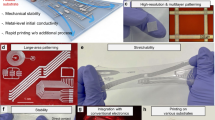Abstract
Room temperature liquid metal (RTLM)-related electronics has recently been found increasingly important in a wide variety of emerging areas. In particular, printable liquid metal ink opens the way for direct writing of electronics spanning form microscale to even nanoscale. However, such fluid-like circuits also raised important fundamental as well as practical issues for solving. A big issue facing its future large-scale application is that the failure features of the conductive wires under electrical current densities are not clear. Here, we discovered for the first time that a liquid metal thin film would be broken by the so-called electromigration effect as the applied current increases to a critical magnitude. A theoretical model was established to preliminarily interpret the phenomena and the related effects. The break-up effect in the liquid metal-based circuits could be one of the major hurdles that must be tackled with caution in the research and application of future liquid metal technologies, especially for the printed microelectronics thus enabled.
Similar content being viewed by others
References
Y. Zheng, Z. He, Y. Gao, and J. Liu, Scientific Reports 3, 1786 (2013).
J. Park, S. Wang, M. Li, C. Ahn, J.K. Hyun, D.S. Kim, D.K. Kim, J.A. Rogers, Y. Huang, and S. Jeon, Nature Communications 3, 916 (2012).
H. Li, Y. Yang, and J. Liu, Appl. Phys. Lett. 101, 073511 (2012).
Q. Zhang, Y. Zheng, and J. Liu, Frontiers in Energy 6, 311 (2012).
Y. Gao, H. Li, and J. Liu, PLoS ONE 7, e45485 (2012).
H. Li and J. Liu, Frontiers in Energy 5, 20 (2011).
D.R. Lide, CRC Handbook of Chemistry and Physics, 90th ed. (CRC Press, 2010).
Y. Deng and J. Liu, ASME J. Electron. Packag. 132, 031009 (2010).
J.R. Black, IEEE Trans. Electron Devices ED 16, 338 (1969).
H.B. Huntington and A.R. Grone, J. Phys. Chem. Solids 20, 76 (1961).
K.H. Bevan, W. Zhu, H. Guo, and Z. Zhang, Phys. Rev. Lett. 106, 156404 (2011).
A. Latz, S. Sindermann, L. Brendel, G. Dumpich, F.-J. Meyer zu Heringdorf, and D.E. Wolf, Phys. Rev. B 85, 035449 (2012).
E. Dalton, I. Clancy, D. Corcoran, A. Arshak, and G. Gooberman, Phys. Rev. Lett. 104, 214101 (2010).
J.P. Dekker, C.A. Volkert, E. Arzt, and P. Gumbsch, Phys. Rev. Lett. 87, 035901 (2001).
K.H. Bevan, H. Guo, E.D. Williams, and Z. Zhang, Phys. Rev. B 81, 235416 (2010).
R.S. Sorbello, A. Lodder, and S.J. Hoving, Phys. Rev. B 25, 6178 (1982).
R.S. Sorbello, Phys. Rev. B 31, 798 (1985).
I.A. Blech, J. Appl. Phys. 47, 1203 (1976).
J.R. Lloyd, J. Clemens, and R. Snede, Microelectron. Reliab. 39, 1595 (1999).
C.K. Hu and J.M.E. Harper, Mater. Chem. Phys. 52, 5 (1998).
S. Mei, Y. Gao, H. Li, Z. Deng, and J. Liu, Appl. Phys. Lett. 102, 041905 (2013).
T. Liu, P. Sen, and C.-J. Kim, J. Microelectromech. Sys. 21, 443 (2012).
M.J. Regan, H. Tostmann, P.S. Pershan, O.M. Magnussen, E. DiMasi, B.M. Ocko, and M. Deutsch, Phys. Rev. B 55, 10786 (1997).
I. Dutta and P. Kumar, Appl. Phys. Lett. 94, 184104 (2009).
W. Jones and H.N. Dunleavy, J. Phys. F: Metal Phys. 9, 1541 (1979).
J.R. Lloyd, Semicond. Sci. Technol. 12, 1177 (1997).
K.N. Tu, Phys. Rev. B 45, 1409 (1992).
J.P. Dekker, A. Lodder, and J. van Ek, Phys. Rev. B 56, 12167 (1997).
P.R. Rimbey and R.S. Sorbello, Phys. Rev. B 21, 2150 (1980).
P.S. Ho and T Kwok, Rep. Prog. Phys. 52, 301 (1989).
M.E. Sarychev, Y.V. Zhitnikov, L. Borucki, C.-L. Liu, and T.M. Makhviladze, J. Appl. Phys. 86, 3068 (1999).
J. Jing, L. Liang, and G. Meng, ASME J. Electron. Packag. 132, 011002 (2010).
M. Pathak, J. Pak, D.Z. Pan, and S.K. Lim, Proc. ICCAD (2011), pp. 555–562.
W. Yang, Mechatronic Reliability (Tsinghua University Press, 2001).
G.K. Batchelor, An Introduction to Fluid Dynamics (New York: Cambridge University Press, 2000).
L.D. Landau and E.M. Lifshitz, Fluid Mechanics, 2nd ed. (Vol. 6, Butterworth-Heinemann, 1987).
Author information
Authors and Affiliations
Corresponding author
Rights and permissions
About this article
Cite this article
Ma, R., Guo, C., Zhou, Y. et al. Electromigration Induced Break-up Phenomena in Liquid Metal Printed Thin Films. J. Electron. Mater. 43, 4255–4261 (2014). https://doi.org/10.1007/s11664-014-3366-0
Received:
Accepted:
Published:
Issue Date:
DOI: https://doi.org/10.1007/s11664-014-3366-0




